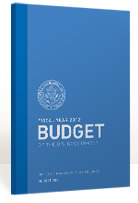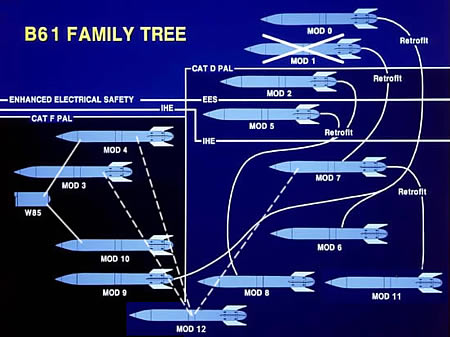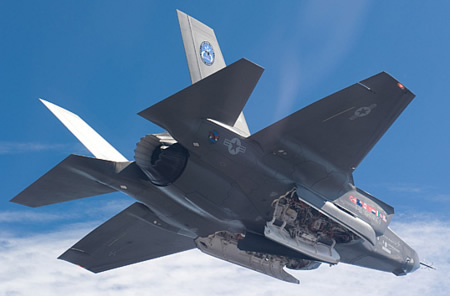The Nuclear Weapons Modernization Budget

The FY2012 budget request includes considerable nuclear weapon modernization
By Hans M. Kristensen
The Obama administration has published its budget request for Fiscal Year 2012, which includes its plans for maintaining and modernizing its nuclear weapons arsenal.
Due to the extensive debate about the New START treaty last year a great deal of the nuclear plans were already known. And the budget request demonstrates that the administration follows through on its promise to modernize the U.S. nuclear weapons arsenal and production facilities.
How this modernization effort will color the administration’s public nuclear legacy remains to be seen.
Warhead Maintenance and Modernization
The budget includes significant investments in maintaining and modernizing the nuclear weapons in the stockpile through the life-extension programs (LEPs). Including the costs from FY2011, the administration plans to spend $6.3 billion through FY2016 on the warheads in the stockpile. Additional LEPs are planned after 2016 (see Stockpile Stewardship Management Plan).
Determining what portion of these costs will be spent on LEPs is difficult because LEP costs for each warhead in the budget are included in the stockpile costs until the LEP gets full go-ahead. That means that stockpile costs are significantly ballooned for some years. When compensating for this accounting rule, the total cost for LEP work in FY2011 through FY2016 is roughly $4.9 billion.
There are three primary LEPs in the budget involving the B61, W76, and W78 warheads. The W88 is also undergoing a small LEP to replace the Arming, Fuzing and Firing (AF&F) unit. Details of the LEPs are:
W76 LEP: Production of W76-1 at the Pantex Plant in Texas is well underway after start-up problems. The first warhead was produced in 2008 and warheads are now being delivered to the navy and deployed on Trident II D5 ballistic missiles. Full-scale production will be achieved in 2013 and continue through 2018. The FY2012 budget request shows $1.5 billion spent on the LEP through FY2016. The LEP extends the life of the warhead for another 30 years and adds new safety features and improves the military capability of the W76.
B61 LEP: Production of a new B61 version called the B61-12 will begin in FY2017 and increase during FY2018 as the W76 production fades out and continue through FY2022. The B61-12 will combine three older B61 versions (B61-3/4/7) into one. The consolidation was previously also scheduled to include the B61-10, a converted W85 Pershing II warhead, but the B61-10 has recently been retired. The B61-12 will reuse the B61 plutonium pit for the primary and reuse or remanufacture the B61-4 secondary. The modification will extend the life of the B61 for another 30 years.
The budget states that the new version will have better reliability, enhanced margin against failure, increasing safety, and improving security and use control. The budget also states that, “insensitive high explosives could replace conventional high explosives,” a curious statement given that the government has previously stated that the remaining B61 versions already have insensitive high explosives.
 |
| The B61-12 will be based on components from three different B61 types: B61-3, B61-4 and B61-7. The secondary will be from the B61-4 or remanufactured. Although the NNSA budget mentions replacing conventional high explosives with insensitive high explosives, all stockpiled B61s already have insensitive high explosives. |
.
W78 LEP: This warhead program is evolving into a whole new experiment with the plan to develop a “common high-surety warhead” for deployment of the Minuteman III ICBMs and Trident II D5 SLBMs. Studies are still defining the full scope of this warhead but it includes new safety and use-control features. A new AF&F will “maximize” use of the fuze program for the navy’s Mk5/W88 program. Approximately $1 billion is budgeted for this LEP through FY2016, but the program extends well beyond 2025 with significant additional costs.
W87: The budget also shows that a new AF&F for the Mk21/W87, the second warhead on the Minuteman III, is being considered to match the W78 LEP. Like the common warhead, this will also maximize use of Mk5 fuze program elements.
W88: Although not yet scheduled to under a full LEP, the Mk5/W88 is undergoing a crash program to replace its AF&F unit. Fuzes are very expensive, and the budget includes roughly $432 million through FY2016. This new fuze technology will probably form the basis for the new fuze planned for the W78 and W87.
The navy budget also indicates development of an advanced radiation-hardened GPS receiver for ballistic missile reentry bodies, a technology that would be required for maneuverable warheads. A flight test of the GPS unit is scheduled for FY2011.
The dismantling of retired warheads does not appear to be a priority for the Obama administration. There are several thousand retired warheads – probably around 3,500 – in storage awaiting dismantlement. Most were retired during the reduction of the stockpile by nearly half in 2004-2007, but the annual dismantlement budget will be less than in 2010 and comparable to that of the Bush administration. The $56.8 million scheduled for FY2012 is a 40% reduction compared with FY2010. At the planned rate, all warheads retired prior to FY2010 will be dismantled by 2022.
Nuclear Delivery Vehicles
In addition to modernizing the warheads and the production complex, the Obama administration has also pledged to spend “well over 100 billion dollars” on modernizing some of the missiles, submarines and bombers designed to deliver the warheads.
Ballistic missile submarine: The next class of ballistic missile submarines – commonly called SSBN(X) – is called Sea Based Strategic Deterrent (SBSD) Advanced Submarine System Development (ASSD) in the budget. The budget includes $781.6 million in FY2012 and shows $5.1 billion through FY2010-FY2016.
 |
| The next SSBN class will have 16 missile tubes, unlike the Ohio-class seen here, which has 24 tubes. The first unit is scheduled to enter service in 2029, carry a life-extended version of the Trident II D5 SLBM, and be in service through the 2080s. |
.
The SSBN development strategy is to maximize re-use of existing Ohio-class SSBN systems and new designs from Virginia-class SSNs.
The budget does not specify the number of missile tubes per submarine, but the Defense Acquisition Board decided in December 2010 that the new design should have 16 tubes. The navy purchased another 24 D5LE missiles in FY12.
The previous ambition to deploy conventional warheads on SLBMs has suffered many setbacks but lives on in the new budget, although only as a study to examine the ambiguity issues involved in launching conventional weapons from a nuclear strike platform and “better understand the capabilities that could be delivered from naval platforms.”
Land-based missiles: There is no money listed in the budget for the initial study of alternatives promised by the Nuclear Posture Review, but a small amount – $2.6 million – are included to study current or “future ICBM weapon systems.” But with the intension to extend the service life of the Minuteman III ICBM through at least 2030 – possibly longer – it is too early for a new missile to appear in the budget. The Minuteman III is in the final phase of a decade-long upgrade that has replaced all major components; it is essentially a new missile.
Efforts to equip ICBMs with conventional warheads continue, and a conventional strike mission integration demonstration study is scheduled for completion at the end of FY2011.
Heavy bombers: Both B-2 and B-52 are being upgraded for the new Advanced Extremely High Frequency (AHEF) satellite constellation, and to equip the bombers with additional nuclear hardening.
The B-2 will be equipped to carry the new B61-12 gravity bomb. The B-52 is undergoing a Reconstitution Study that will provide for further nuclear weapons in both bay and under wings. One of these is the Long Range Stand-Off (LRSO) cruise missile intended to replace the Air Launched Cruise Missile (ALCM) in 2030. The warhead might be the W80-3, a modified LEP version of the current W80-1. Nearly $10 million are scheduled to study the new missile in FY2012, with a total of $884,297 million through FY12-16.
The budget does not present a schedule for the next generation bomber, but it is in design development with $197,023 earmarked for FY2012 and $3.94 billion through FY2016. [Update: According to The Hill, Pentagon comptroller Robert Hale stated that the plan is to build 80-100 new bombers to replace the B-2 and B-52H. Only a portion of these would, presumably, become nuclear-capable.]
Fighter-bombers: The budget gives new details about the scope and nuclear capability of the Joint Strike Fighter. Follow-on development will be initiated of the F-35A CTOL Variant Air Vehicle for dual-capability (DCA). DCA integration is scheduled for FY2011-FY2017 with nuclear capability added in the first post-SDD (System Development and Demonstration) block upgrade (Block IV). F-35A will have capability to carry two B61s internally. There are $10 million budgeted for FY2012 with $262.7 million through FY2016 to support Joint Strategic Capabilities Plan (JSCP) requirements from FY2017.
 |
| The F-35A CTOL (conventional take off and landing) will be capable of carrying two B61-12 nuclear bombs, one in each bay. |
.
The F-35A Block IV will replace the F-15E and F-16 in the nuclear mission and also be offered to NATO allies that are tasked to deliver U.S. nuclear weapons.
Nuclear Factories
The budget provides new cost estimates for the two new nuclear weapons production factories that are under construction; the CMRR (Chemistry and Metallurgy Research Replacement) facility at Los Alamos National Laboratory in New Mexico, and the UPF (Uranium Production Facility) at the Y-12 complex in Oak Ridge, Tennessee. Both factories are already over budget.
Based on 45% design completion, the CMRR is now estimated to cost $3.7-$5.8 billion to complete. The UPF is estimated at $4.2-$6.5 billion. A total of $9.9-$12.3 billion. But even this is probably too low and NNSA promises that a new estimate will come in FY2013 after the factories reach 90% design completion. Full operation of the two factories is planned for FY2023 and FY2024, respectively. GAO recently concluded that NNSA has very poor basis for making realistic cost estimates.
Implications and Outlook
With massive investments in widespread modernization of nuclear forces and industry, the FY2012 budget shows that the Obama administration is following through on its promise to make significant investments in modernizing the U.S. nuclear deterrent.
The “generational” modernizations proposed in the budget represent a commitment to extending the nuclear era as long into the future as it has lasted so far. A challenge will be whether nuclear modernization will overshadow nuclear disarmament in the administration’s public nuclear image.
Following on the heels of the Prague speech and the New START treaty, it remains to be seen whether other nuclear weapon states and the international non-proliferation community will see the nuclear modernization programs as progress toward reducing the role and numbers of nuclear weapons and putting an end to Cold War thinking, or business as usual only at lower numbers.
To what extent the Congress will fund these programs is another unknown. With unprecedented deficit and a new Congress that appears determined to cut government spending, several of the nuclear modernization programs will like come under considerable scrutiny.
This publication was made possible by a grant from Carnegie Corporation of New York and Ploughshares Fund. The statements made and views expressed are solely the responsibility of the author.
The United Kingdom is modernizing its stockpile of nuclear weapons and delivery systems, as detailed today in the Federation of American Scientists latest edition of its Nuclear Notebook, “United Kingdom Nuclear Forces, 2024”.
FAS believes the resolution is a necessary advancement of scientific understanding of the devastating consequences of a nuclear war.
The U.S. should continue its voluntary moratorium on explosive nuclear weapons tests and implement further checks on the president’s ability to call for a resumption of nuclear testing.
To help protect U.S. critical infrastructure workers, the next presidential administration should ensure ample supplies of high-quality respiratory personal protective equipment.